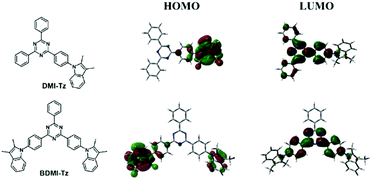2,3-Dimethylindole as a donor for novel thermally activated delayed fluorescence emitters†
Abstract
Two indole derivative-based light-emitting molecules are synthesized and studied. They share the same donor unit, 2,3-dimethylindole, and release similar emission colors. In addition, they posses almost the same lowest unoccupied molecular orbital and highest occupied molecular orbital energy levels. However, the discrepancy in the amount of 2,3-dimethylindole donor units in each molecule, results in different energy gaps between singlet and triplet states, and different reverse intersystem crossing process efficiency. OLED devices based on these 2,3-dimethylindole compounds display external quantum efficiencies of 6.3% and 16.5% with greenish blue emission.



 Please wait while we load your content...
Please wait while we load your content...